Introduction:
Screen preparation for screen printing is described easy way step by step in this article. Printing on cotton can be done through various methods, such as screen printing, digital printing, heat transfer printing, and sublimation printing. Screen printing involves creating a stencil on a mesh screen and using a squeegee to push ink through the stencil onto the cotton fabric. This method is ideal for larger orders of t-shirts or other cotton garments. Digital printing uses a specialized inkjet printer to print the design onto the cotton fabric directly. This method is suitable for smaller orders or complex designs with many colors or gradients. Heat transfer printing involves printing the design onto transfer paper and using heat to transfer the design onto the cotton fabric. This method is suitable for smaller orders or designs with great detail. Sublimation printing involves using a special ink and transfer paper to print the design onto a sublimation-compatible material, which is then heat-pressed onto the cotton fabric. This method is ideal for designs that require high-quality and long-lasting prints. When choosing a printing method for cotton, it is essential to consider factors such as the design, the quantity of items to be printed, and the desired quality of the final product. In addition to the printing methods mentioned above, there are other factors to consider when printing on cotton. One important factor is the type of cotton fabric being used. For example, 100% cotton fabric will absorb more ink and produce a more vibrant print than a cotton blend fabric. Another consideration is the color of the cotton fabric. Lighter-colored fabrics will produce brighter and more vibrant prints, while darker-colored fabrics may require under a base layer of white ink to make the design pop. It’s also essential to choose suitable ink for the printing method. Different inks have different properties, such as drying time, durability, and color vibrancy. Water-based inks are commonly used for screen printing on cotton, while sublimation printing requires specialized dye sublimation ink.
Finally, ensuring the printing process is done correctly is important to achieve the desired result. This may include proper pre-treatment of the fabric, correct ink application and curing, and quality control measures to ensure that the final product meets the desired standards.
Basic Textile Printing Methods:
There are several different printing techniques that can be used for various types of printing applications. But three of the most commonly used techniques include:
- Direct printing
- Discharge printing
- Resist printing
1. Direct Printing:
Direct printing is a technique that involves printing an image or design directly onto a surface without the need for an intermediate transfer medium. In fabric printing, direct printing refers to printing a design directly onto fabric without using transfer paper or any other intermediary material. Direct printing on fabric can be done using various methods, such as screen printing, digital printing, direct-to-garment printing, carved block, stencil, and engrave roller. Each method has advantages and disadvantages and is suitable for different types of fabric and design requirements. Screen printing involves creating a stencil on a mesh screen and using a squeegee to push ink through the stencil onto the fabric. Screen printing is ideal for printing more significant quantities of fabric and can produce highly detailed designs with vibrant colors. Digital printing involves using a specialized inkjet printer to print the design onto the fabric directly. This method is suitable for printing smaller quantities of fabric and can produce highly detailed designs with many colors. Direct-to-garment printing is a newer technique that uses a specialized printer to print the design directly onto the fabric, similar to a digital printer. This method is suitable for printing smaller quantities of fabric and can produce highly detailed designs with many colors.
Direct printing on fabric has several advantages, including a high level of detail and color accuracy and the ability to print small quantities. However, direct printing may only be suitable for some types of fabric or designs, and it is essential to choose the right printing method for the specific requirements of each project.
2. Discharge Printing:
Discharge printing is a technique used to print designs onto dark-colored fabric. The process involves removing the dye or color from the fabric rather than adding ink on top of the fabric. A discharge agent is applied to the fabric, eliminating the dye or pigment from the fabric in the areas where the design is to be printed. The fabric is then washed to remove any remaining discharge agent, and the resulting print appears as a lighter shade of the original fabric color.
Discharge printing is famous for its ability to produce soft, breathable prints that are ideal for t-shirts and other garments. However, the process can be more complex and time-consuming than traditional printing methods and may only be suitable for some fabrics or designs. Working with a reputable printing company with experience with discharge printing is essential to ensure the best possible results.
3. Resist Printing
Resist printing is a technique used to create designs on fabric by blocking or resisting the dye in certain areas. The process involves applying a resist substance to the fabric before dyeing, which creates a barrier that prevents the dye from penetrating those areas. When the resist is removed, the fabric underneath remains undyed, creating the desired design.
There are several types of resist printing techniques, including:
- Batik: This is a traditional resist printing technique that involves applying hot wax to the fabric before dyeing. The wax creates a resist barrier, and when the fabric is dyed, the waxed areas resist the dye, creating a design.
- Tie-dye: This is a popular resist printing technique that involves tying and binding sections of fabric before dyeing. The tied areas resist the dye, creating a unique and often colorful design.
- Block printing: This is a technique where a design is carved into a block, and then ink is applied to the block and stamped onto the fabric. The inked areas create a resist barrier that prevents dye from penetrating the fabric, creating a design.
Resist printing is a versatile technique that can be used to create a wide range of designs and patterns on fabric. However, it requires skill and practice to achieve the desired results, and the final outcome can be influenced by factors such as the type of resist used, the dyeing process, and the type of fabric.
This article will explain the process of preparing a screen for screen printing.
Flow-chart of Screen Preparation for Screen Printing:
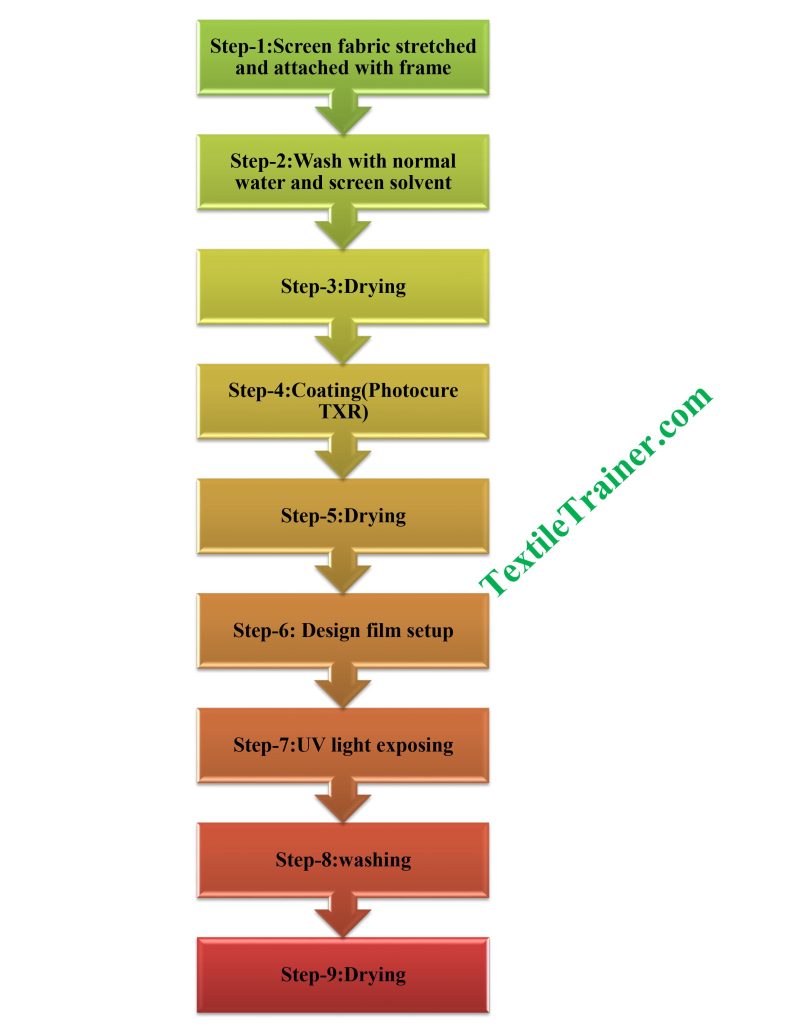
Now, I will explain all the process step by step in details
Step-1: Screen fabric stretched and attached with frame
First, select a screen frame that is the appropriate size for your design. Screen frames are typically made of wood or aluminum and are available in various sizes. Cut a piece of mesh fabric that is larger than the screen frame. Make sure to leave enough fabric to wrap around the frame. Place the mesh fabric on top of the screen frame and use a staple gun to attach one end of the fabric to the frame. Pull the fabric taut and staple the opposite end to the frame. Repeat the process for the remaining two sides, pulling the fabric as tightly as possible.
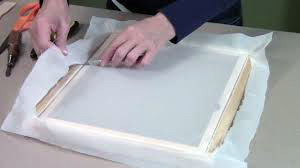
Step-2: Wash with normal water and screen solvent
It’s important to thoroughly clean the screen using a combination of normal water and screen solvent to ensure that all dust is removed from the mesh fabric. This will ensure that the printing process goes smoothly and that the final print is high quality.
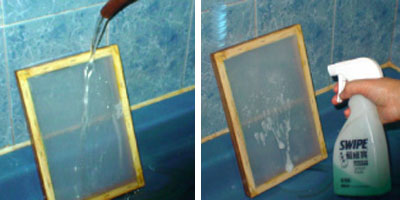
Step-3: Drying
Then dry the screen to remove water. Screen is dried about 550 for min.
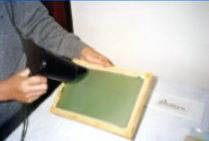
Step-4: Coating (Photocure TXR)
To apply the emulsion onto the mesh fabric of a screen frame during the screen coating process, use a squeegee to spread the emulsion on both sides of the screen. Since emulsion is a liquid, it will naturally seep through the mesh and onto the other side when applied. It is important to ensure that the emulsion is spread evenly on both sides of the screen to create a smooth and uniform coating. To check this, hold up the screen frame to a light source to see if there are any areas where the emulsion has yet to be applied or is too thin. Ensuring that the screen is coated as evenly as possible is essential for creating a high-quality stencil that will result in a successful print. Take your time during this step, use a steady hand, and be sure to cover all areas of the mesh fabric to achieve the desired result. This work must be done in a dark room.
Two coating chemical is need to make emulsion. They are:
- Autosol-99%
- Sensitizer (K2Cr2O7)-1%
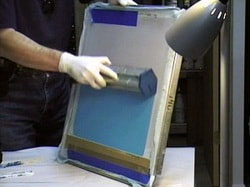
Step-5: Drying
After applying emulsion onto the mesh fabric of a screen frame during the screen coating process, the screen frame must be allowed to dry in a dark room or under a yellow light. This is because the emulsion is photosensitive and will react to light, causing it to harden and create a stencil. The drying process typically takes 5 min, and a temperature is 550. During this time, the emulsion must be protected from light sources that could harden it prematurely. A dark room or yellow light is used to ensure that the emulsion remains wet and does not start to harden before it is exposed to light to create the stencil. Once the emulsion is thoroughly dried and ready to be exposed to sunlight, a transparency film with the design is placed on the screen and exposed to light.
Step-6: Design film setup
To prepare for screen printing, you will require transparency of the design you want to print. Ensure the image is in black and white, which will help create a clear and precise stencil for the printing process.
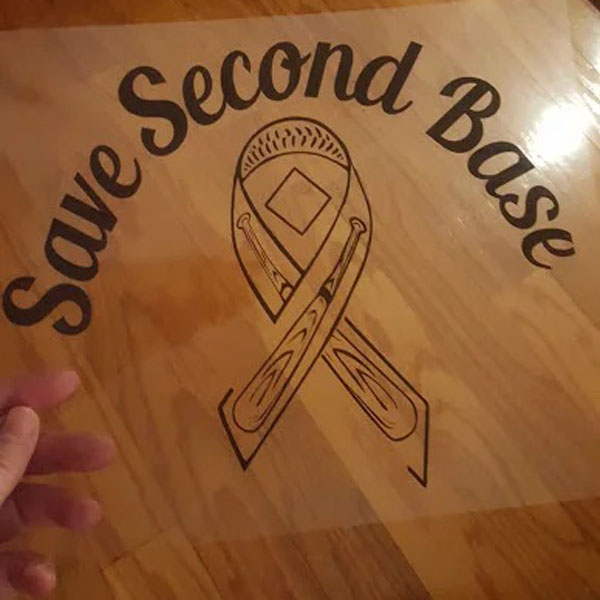
Step-7:UV light exposing
U.V. light exposure is a critical step in the screen printing process for fabric. Once the emulsion has been applied onto the mesh fabric and allowed to dry, a transparency film with the design is placed on top of the screen and secured in place. The screen is then exposed to U.V. light, which causes the emulsion in the unexposed areas of the screen to harden and become insoluble. The length of time the screen is exposed to U.V. light will depend on a few factors, such as the strength of the light source and the type of emulsion being used. The exposure time may need to be adjusted accordingly for optimal results. But approximately 10-15 seconds are required.
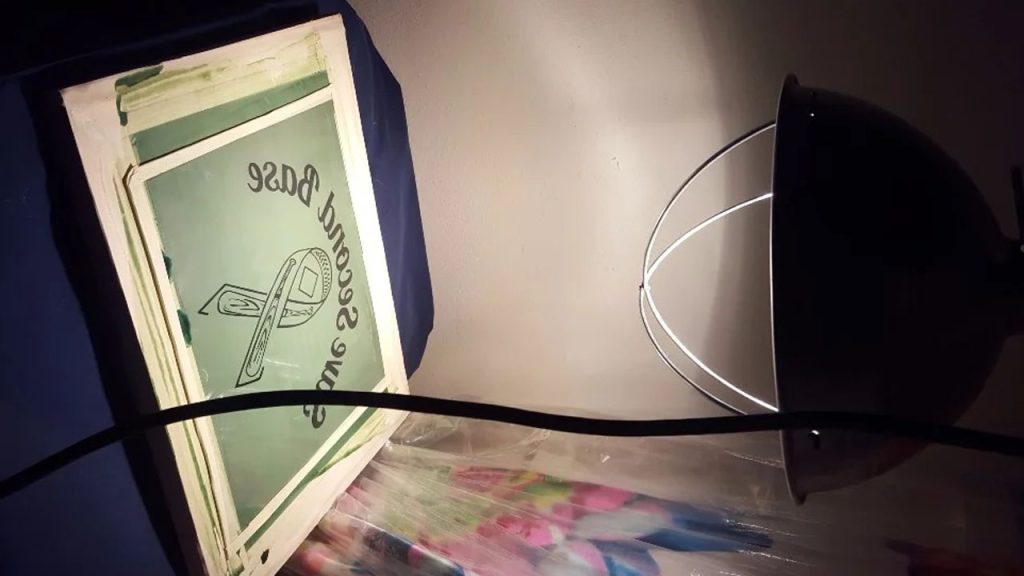
Step-8: Washing
After the screen is exposed to the U.V. light, it is rinsed with water. The areas of the screen that were not exposed to the light will dissolve, leaving behind the hardened emulsion in the shape of the desired design. This stencil will then be used to transfer ink onto the fabric during the printing process. It is important to handle the screen carefully during exposure to ensure that the transparency film remains securely in place and the emulsion is evenly exposed to the U.V. light. You can create a high-quality stencil with proper exposure and handling to produce a successful and precise print on the fabric.
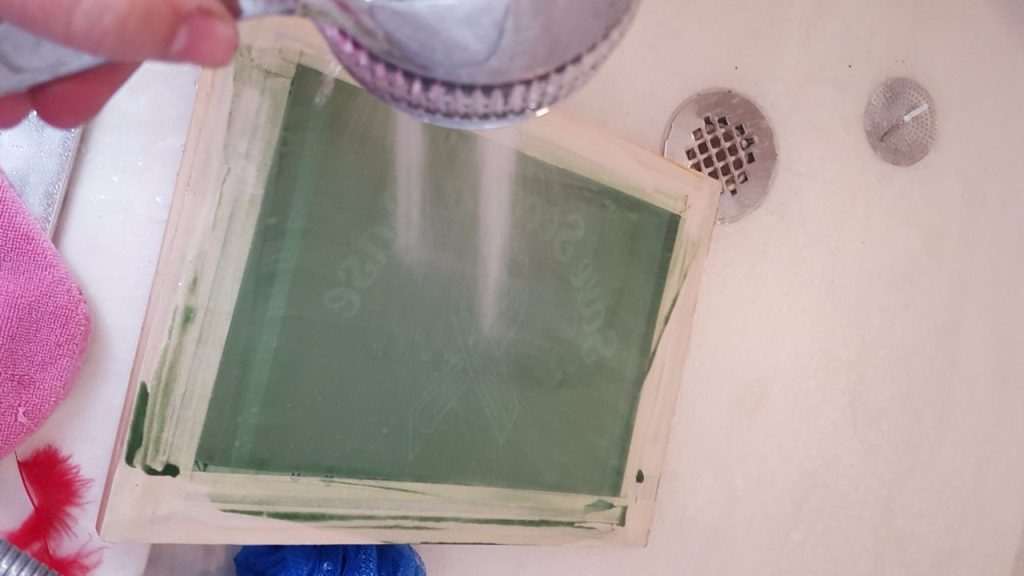
Step-9: Drying
After washing, the screen needs to be fully dry before it can be used for printing. This can be achieved by leaving the screen in a well-ventilated area for a few hours or using a drying cabinet or fan to speed up the process. It is important to ensure that the screen is completely dry before starting the printing process, as any residual moisture can cause the ink to bleed or affect the adhesion of the ink to the fabric. Proper screen drying is essential to ensure a successful and high-quality print on the fabric.
It is important to ensure that the screen is completely dry before starting the printing process, as any residual moisture can cause the ink to bleed or affect the adhesion of the ink to the fabric. Proper screen drying is essential to ensure a successful and high-quality print on the fabric.
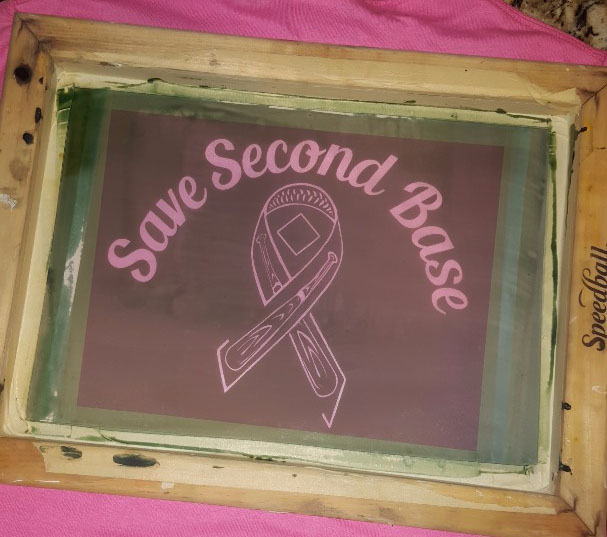
These are the step of screen preparation for screen printing
Conclusion:
In conclusion, screen printing is a versatile and popular application technique, from t-shirts and textiles to packaging and promotional materials. The process involves preparing a screen with emulsion and creating a stencil through exposure to U.V. light, which is then used to transfer ink onto the printed fabric or material. Proper screen preparation is crucial to achieving a successful and high-quality print. This includes choosing the suitable mesh fabric, applying emulsion evenly, and ensuring the screen is completely dry before use. U.V. light exposure is a critical step in the screen printing process. Proper exposure times and handling are essential to creating a high-quality stencil that will produce a clear and vibrant print. The drying process of the screen is also a necessary step in the screen printing process. Ensuring the screen is fully dry before proceeding with the following steps is crucial to achieving a successful print.
By following these steps and techniques, screen printing can be a fun and rewarding way to create custom designs and prints for various applications. With practice and attention to detail, you can easily create stunning and professional-looking prints.
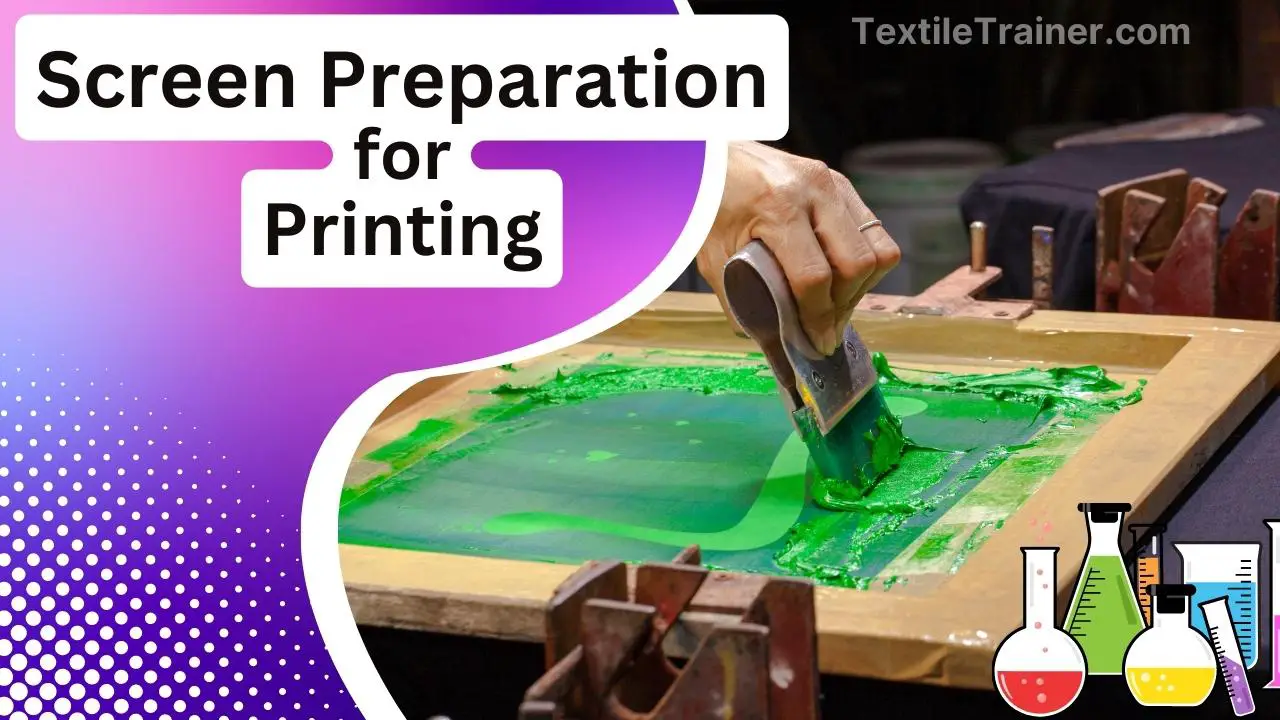

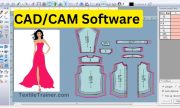


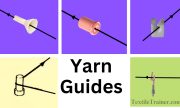

Im grateful for the blog post.Really looking forward to read more. Will read on…
ok. we will try.
Really appreciate you sharing this article.Thanks Again. Really Great.
keep visit our site…..
Thank you for your blog article.Thanks Again. Really Cool.
please support us….
Thank you for your blog.Really looking forward to read more. Want more.
I will try…
Really enjoyed this blog post.Really thank you! Great.
thanks too. please support us.
Hi there, yup this post is genuinely nice and I have learned lot of things from it concerning blogging. thanks.
thank too…..please support us…
It is actually a nice and useful piece of info.I’m happy that you simply shared this useful info with us.Please keep us up to date like this. Thank you for sharing.
thanks too. please support us.
I love reading an article that can make people think. Also, many thanks for allowing me to comment.
keep visit our site…thank too..
I cannot thank you enough for the blog article. Want more.
ok, I will try.
Remarkable! Its in fact amazing article, I have got much clear idea on the topic of from this paragraph.
keep visit our site…
I appreciate you sharing this article post.Really looking forward to read more. Great.
Thanks
Everyone loves what you guys tend to be up too. Such clever work and coverage! Keep up the fantastic works guys I’ve you guys to my personal blogroll.
great points altogether, you simply won a brand new reader.What would you suggest in regards to your put up that you simply madea few days ago? Any sure?
When I originally commented I clicked the « Notify me when new comments are added » checkbox and now each time a comment is added I get four e-mails with the same comment. Is there any way you can remove me from that service? Thank you!
Thanks too
Thanks
Looking forward to reading more. Great article post.Thanks Again. Really Cool.
Thanks too
I am sure this article has touched all the internet users, its really really nice post on building up new blog.
Thanks a lot
It’s an amazing piece of writing in support of all the online viewers; they will take advantage fromit I am sure.
Thank you
Im grateful for the post.Really looking forward to read more. Great.
Keep visit our site
I adore meeting useful info, this post has got me even more info!
Thank you
Greetings! Very useful advice in this particular post!It’s the little changes that produce the greatest changes.Thanks for sharing!My blog: sseg.s27.xrea.com
Thanks for the auspicious writeup. It actually was a enjoyment account it. Look complex to more delivered agreeable from you! However, how could we communicate?
I will immediately take hold of your rss feed as I can not to find your e-mail subscription link or e-newsletter service.Do you have any? Please permit me recognise so that I could subscribe.Thanks.
That is a good tip especially to those fresh to the blogosphere.Brief but very precise information… Many thanks for sharing this one.A must read post!
I value the article.Really looking forward to read more. Really Cool.
I really like and appreciate your article.Really looking forward to read more. Great.
A round of applause for your article.Thanks Again. Fantastic.
Major thankies for the blog post. Will read on…
Appreciate you sharing, great blog article. Keep writing.
Greetings! Very useful advice in this particular article! It is the little changes that produce the largest changes. Many thanks for sharing! view all
keep visiting our site….
Great, thanks for sharing this blog post. Want more.
Enjoyed every bit of your article.Really thank you! Keep writing.
Thanks for the blog article.Really thank you!
A big thank you for your blog post. Awesome.
keep visit our site….
Thanks a lot for the post. Keep writing.
Major thanks for the article.Really looking forward to read more. Really Cool.
Really enjoyed this blog article.
Thank you ever so for you blog post.Thanks Again. Really Cool.
I’ll right away grasp your rss feed as I can not in finding your email subscription linkor e-newsletter service. Do you’ve any? Please let me understand in order that I may subscribe.Thanks.
Muchos Gracias for your blog.Thanks Again. Cool.
I cannot thank you enough for the blog post.Really thank you! Really Cool.
I do accept as true with all the ideas you have introduced for your post. They’re very convincing and can definitely work. Still, the posts are too brief for newbies. May you please extend them a bit from subsequent time? Thanks for the post.
Thanks again for the article post. Keep writing.!!!
I love the way you have actually ended this blog post …
Appreciate you sharing, great post. Cool.
Thanks so much for the blog article.Really thank you! Really Cool.
I am so grateful for your blog.Really thank you! Keep writing.
I appreciate you sharing this blog.Really thank you! Really Cool.
Thank you ever so for you blog.Really looking forward to read more.
Incredible points. Outstanding arguments. Keep up the great work.
Im thankful for the blog article.Really looking forward to read more.
Talk to the manager or supervisor they will understand your need as they have spent a lot of time in this service sector.
Great post can make continuous improvement, thanks reveal, the actual build up associated with understanding would be to maintain understanding, interest is actually the start of prosperity.
Thank you
Looking forward to reading more. Great article. Want more.
Great, thanks for sharing this article post.Much thanks again. Will read on…
Im obliged for the blog article.Really thank you! Want more.
Really enjoyed this article post.Really looking forward to read more.
Thanks for sharing, this is a fantastic post.Really thank you! Great.
I am so grateful for your article.Thanks Again. Awesome.
Looking forward to reading more. Great article post.Much thanks again. Fantastic.
Major thanks for the blog article.Much thanks again. Want more.
Major thanks for the blog article.Thanks Again. Much obliged.
I am so grateful for your post. Really Great.
Fantastic blog post.Thanks Again. Great.
I truly appreciate this article.Much thanks again. Awesome.
This is one awesome article. Really Great.
I appreciate you sharing this article post.Really thank you! Keep writing.
I appreciate you sharing this article post.Really thank you! Cool.
Great, thanks for sharing this blog article.Really thank you! Want more.
Thank you for your article. Really Great.
Im obliged for the post.Really looking forward to read more. Much obliged.
Awesome article post.Really thank you! Keep writing.
I think this is a real great post.Much thanks again. Awesome.
I really enjoy the blog.Really thank you! Keep writing.
Great, thanks for sharing this blog post.Much thanks again.
I value the blog article.Thanks Again. Awesome.
Very informative blog post.Really looking forward to read more. Awesome.
It’s great that you are getting thoughts from this post as well as from our discussion made here.
Absolutely composed content material, Really enjoyed reading through.
Wow, great blog.Really thank you! Really Cool.
I appreciate you sharing this article.Thanks Again. Cool.
I really like and appreciate your article post.Thanks Again.
Thank you for your blog.Really thank you! Great.
Very neat blog article.Really looking forward to read more. Great.
Im grateful for the blog.Thanks Again. Awesome.
Very informative post.Thanks Again. Awesome.
I think this is a real great post.Really looking forward to read more. Awesome.
Very informative article.Much thanks again. Much obliged.
Thank you ever so for you blog post.Thanks Again.
Very good blog article.Really looking forward to read more.
Thanks for the article post.Thanks Again. Really Cool.
wow, awesome blog article. Much obliged.
Very informative post.Really thank you! Much obliged.
Hey, thanks for the blog post.Really thank you! Fantastic.
I value the blog.Really thank you! Cool.
I think this is a real great blog article.Really looking forward to read more.
Thanks a lot for the post.Really thank you! Really Cool.
Major thanks for the blog.Really looking forward to read more. Keep writing.
I truly appreciate this blog post.Thanks Again. Awesome.
wow, awesome article.Thanks Again. Really Great.
Say, you got a nice post.Much thanks again. Keep writing.
Im grateful for the blog post.Really thank you! Really Great.
Im grateful for the article.Much thanks again. Really Great.
Hey, thanks for the article.Much thanks again. Great.
Very good article post.Really looking forward to read more.
Im obliged for the post.Thanks Again. Great.
Thank you ever so for you post.Really looking forward to read more. Great.
Major thankies for the blog post. Fantastic.
I really liked your article post.Really thank you! Cool.
I really like and appreciate your blog article.Much thanks again. Great.
I think this is a real great post.Thanks Again. Much obliged.
Thanks for sharing, this is a fantastic blog.Thanks Again. Really Cool.
A big thank you for your article.Thanks Again. Cool.
Thanks a lot for the article post. Cool.
Thanks for sharing, this is a fantastic blog post.Much thanks again. Awesome.
This is one awesome article.Really looking forward to read more. Fantastic.
Hey, thanks for the blog.Thanks Again. Awesome.
Major thankies for the blog post. Cool.
Awesome article post.Really thank you! Want more.
Im thankful for the blog post.Much thanks again. Really Great.
Im thankful for the article post. Really Great.
I really enjoy the blog.Really looking forward to read more.
Thanks for sharing, this is a fantastic article.Thanks Again. Really Cool.
Thanks for sharing, this is a fantastic post.Really thank you! Keep writing.
I loved your article post. Great.
I cannot thank you enough for the article post.Thanks Again. Really Cool.
I loved your blog article. Much obliged.
A big thank you for your post.Much thanks again. Really Cool.
I think this is a real great blog post.Thanks Again. Really Cool.
There’s certainly a great deal to find out about this subject. I like all the points you made.
Thank you for your blog article. Much obliged.
Very informative post.Thanks Again. Really Great.
Thank you for your post.Thanks Again. Great.
Major thanks for the blog.Much thanks again. Really Cool.
Thanks so much for the post.Much thanks again. Really Cool.
I truly appreciate this post.Much thanks again. Really Great.
wow, awesome blog.Really thank you! Cool.
Hey, thanks for the article.Thanks Again. Cool.
Looking forward to reading more. Great blog article.Really looking forward to read more. Really Cool.
Many thanks for sharing your views about meta_keyword. Regards
Thanks for sharing, this is a fantastic blog article.Thanks Again. Cool.
Very good article.Thanks Again.
Wow, great blog article. Cool.
I really like and appreciate your article.Thanks Again. Keep writing.
Really informative blog article. Want more.
Very neat article.Much thanks again. Really Cool.
Great blog.Thanks Again. Will read on…
Heya i’m for the primary time here. I came across this board and I find It truly useful & it helped me out much.I hope to give something again and help others like you helped me.
Thanks
Muchos Gracias for your post. Great.
I’d should check with you here. Which is not something I often do! I enjoy studying a post that will make folks think. Also, thanks for permitting me to comment!
That is a good tip especially to those fresh to the blogosphere. Simple but very accurate information… Thanks for sharing this one. A must read post!
Thanks
Hey, thanks for the post.Really thank you! Want more.
Hey, thanks for the blog article.Much thanks again. Fantastic.
I truly appreciate this article.Thanks Again. Really Great.
Hi there, I read your new stuff daily. Your humoristic style is awesome, keep up the good work!
Looking forward to reading more. Great post. Really Cool.
A big thank you for your blog.Really thank you! Keep writing.
I really liked your blog. Much obliged.
Major thanks for the blog. Really Cool.
Thanks so much for the blog.Really thank you! Cool.
Fantastic article.Really thank you! Want more.
Say, you got a nice post.Thanks Again. Much obliged.
Enjoyed every bit of your post.Really thank you! Much obliged.
Great article post.Really thank you! Want more.
Thanks a lot for the post.Really thank you! Cool.
Thanks so much for the blog. Will read on…
I think this is a real great post.Thanks Again. Cool.
Wow, great article.Thanks Again.
I really enjoy the article post. Really Cool.
I value the blog.Much thanks again. Really Cool.
I value the blog post.Really thank you! Will read on…
Awesome post.Really thank you! Will read on…
I really enjoy the blog article.Thanks Again.
Really informative post.Much thanks again. Awesome.
Really informative blog. Fantastic.
Say, you got a nice blog article.Thanks Again. Great.
Looking forward to reading more. Great article. Fantastic.
I value the article.Really thank you! Really Great.